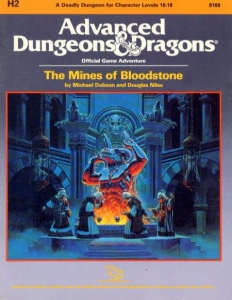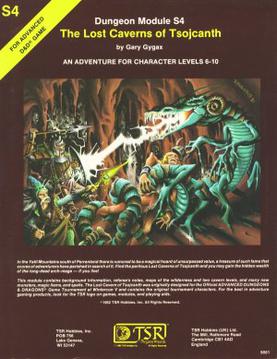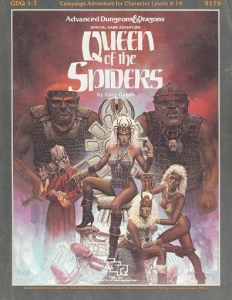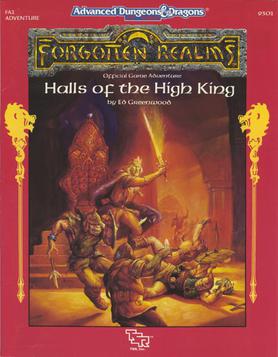
Stormbringer is a magic sword featured in a number of fantasy stories by the author Michael Moorcock. It is described as a huge, black sword covered with strange runes, created by the forces of Chaos with its own will. It is wielded by the doomed albino emperor Elric of Melniboné. Stormbringer makes its first appearance in the 1961 novella The Dreaming City. In the four novellas collected in the 1965 book Stormbringer, the sword's true nature is revealed.

Queen of the Demonweb Pits (Q1) is an adventure module for the Dungeons & Dragons roleplaying game written by David Sutherland. The "Q" in the module code is an abbreviation for "queen". The module, a sequel to the D series of modules, was novelized in 2001.
Tiamat is a supremely strong and powerful 5-headed draconic goddess in the Dungeons & Dragons role-playing game. The name is taken from Tiamat, a goddess in ancient Mesopotamian mythology. She is the queen and mother of evil dragons and a member of the default pantheon of Dungeons & Dragons gods. Her symbol is a five-headed dragon.

H1 Bloodstone Pass is an adventure module for the first edition of the Advanced Dungeons & Dragons (D&D) fantasy role-playing game. It was written by Douglas Niles and Michael Dobson and published by TSR, Inc., in 1985. While it contained some traditional D&D elements, the main portion of the module was a series of mass battles using the D&D Battlesystem.

H2 The Mines of Bloodstone is an official game adventure or "module" for the Advanced Dungeons & Dragons fantasy role-playing game.

H3 - The Bloodstone Wars is an Official Game Adventure or "module" for Advanced Dungeons & Dragons.

The Lost Caverns of Tsojcanth is an adventure module for the Dungeons & Dragons fantasy role-playing game. It was written by Gary Gygax and published by TSR in 1982 for the first edition Advanced Dungeons & Dragons (AD&D) rules. The 64-page adventure bears the code "S4" and is set in the Greyhawk campaign setting. It is divided into two parts, a 32-page adventure, and a 32-page booklet of monsters and magic items. The plot involves the player characters investigating rumors of lost treasure. After traversing a wilderness and two levels of dungeons, the players face Drelnza, the vampiric daughter of long-deceased archmage Iggwilv.

The lich is an undead creature found in the Dungeons & Dragons (D&D) fantasy role-playing game. Liches are spellcasters who seek to defy death by magical means.

The Bloodstone Lands is a module for the Forgotten Realms campaign setting for the 2nd edition of Advanced Dungeons & Dragons. It is also known by its product code FR9.

Queen of the Spiders is an adventure module for the Dungeons & Dragons fantasy role-playing game. It was published by TSR, Inc. in 1986 and is a compilation of seven previous related modules, often referred to as a "supermodule." Together, the seven adventures form an integrated campaign that begins in the World of Greyhawk, continues underground into the Underdark, and concludes in the Demonweb Pits, the abyssal lair of the demonic goddess Lolth. The campaign was originally intended for use with the rules from the first edition of Advanced Dungeons & Dragons.

Halls of the High King (ISBN 0-88038-881-1) is an adventure module for the fictional Forgotten Realms campaign setting for the second edition of the Advanced Dungeons & Dragons fantasy role-playing game. The book, with product code TSR 9301, was published in 1990, and was written by Ed Greenwood, with cover art by Jeff Easley and interior art by Tim Bradstreet and Rick Harris.

Dead Gods is an adventure module for the second edition of the Advanced Dungeons & Dragons fantasy role-playing game.

Destiny of Kings is a 1986 adventure module for the Advanced Dungeons & Dragons fantasy role-playing game.

Saga of the Shadow Lord is a 1986 adventure module for the Basic Rules of the Dungeons & Dragons fantasy role-playing game.
The Wand of Orcus is a fictional magical weapon described in various Dungeons & Dragons media. Because of the popularity of Orcus as a villain within the Dungeons & Dragons universe, many different authors have written materials describing artifacts created by or associated with the character. The Wand of Orcus is consistently the most important and most described of these artifacts. Screen Rant has noted that "[t]he weapon that Orcus wields in battle is almost as famous as the demon lord himself". Furthermore, the device has at times been employed in books, games, and other media within the franchise as a thing distinct from Orcus himself, such that adventurers may encounter the wand as a freestanding element of the game or story.

Prince of Undeath is an adventure module for the 4th edition of the Dungeons & Dragons fantasy role-playing game.

In the Dungeons & Dragons fantasy role-playing game, "monsters" are generally the antagonists which players must fight and defeat to progress in the game. Since the game's first edition in 1974, a bestiary was included along other game manuals, first called Monsters & Treasure and now commonly called the Monster Manual. Described as an "essential" part of Dungeons & Dragons, the game's monsters have become notable in their own right, influencing fields such as video games and fiction, as well as popular culture.














